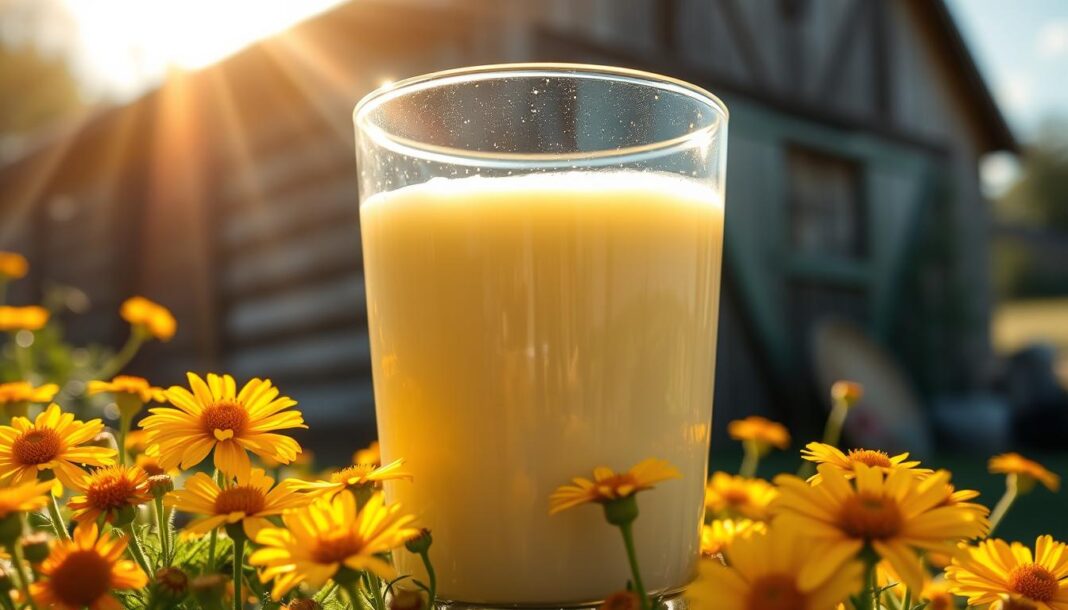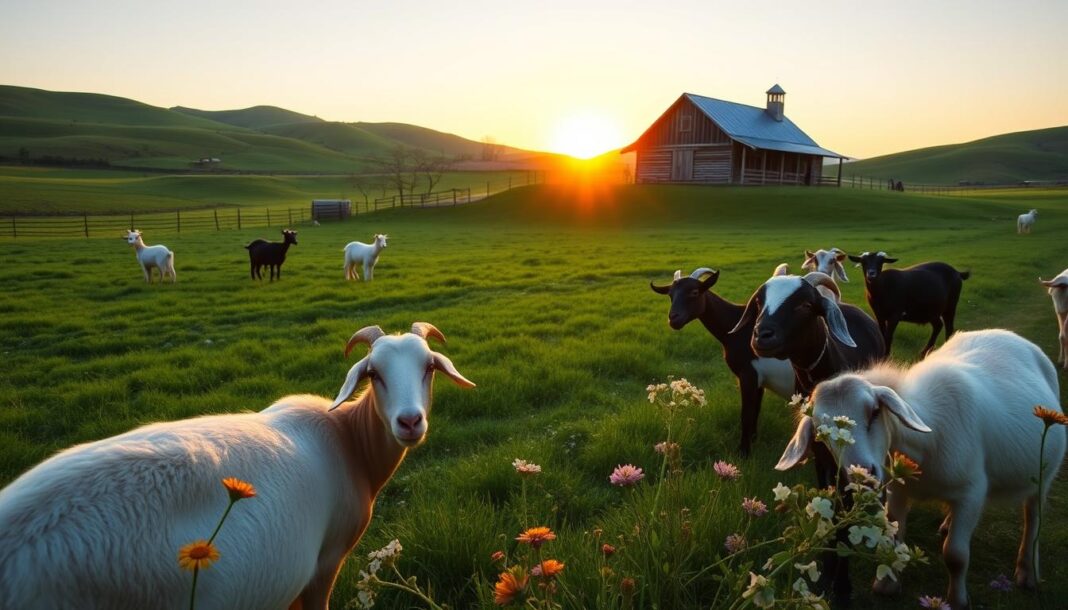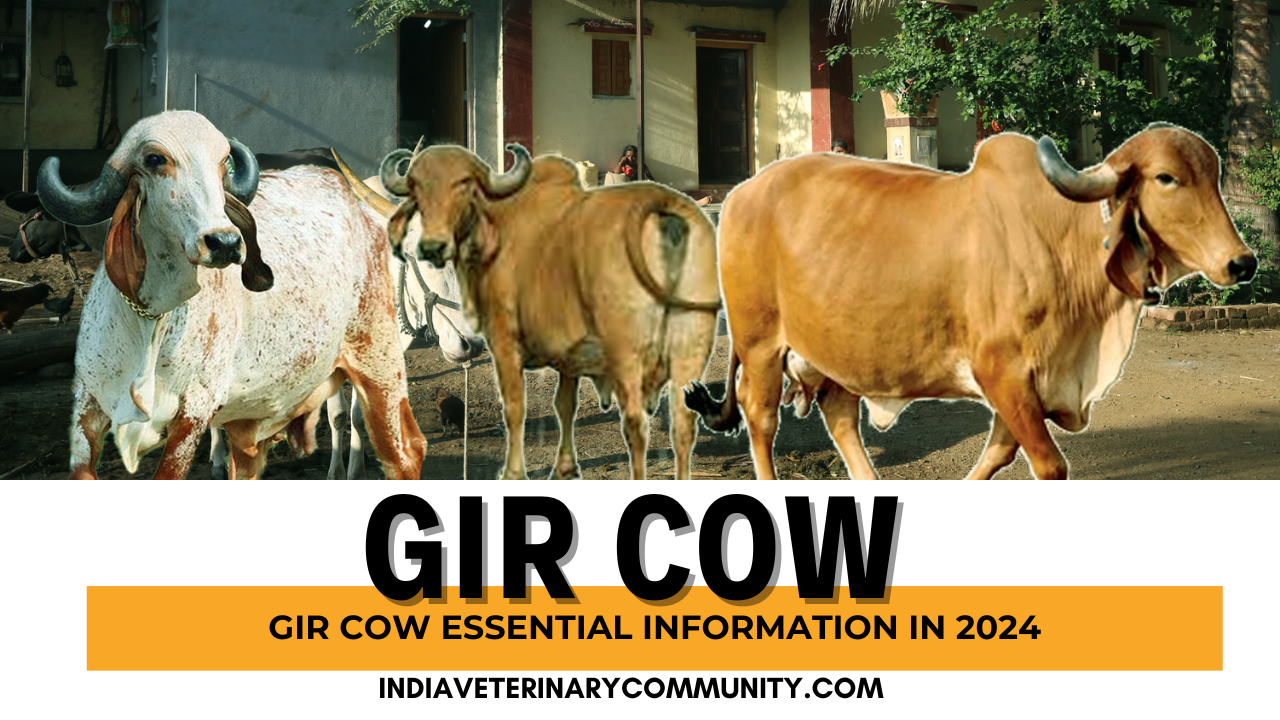Why Cow Milk is Yellow?
The yellow color of cow milk is not random. It comes from the cow’s diet and the natural compounds in their milk. Carotenoids, which are fat-soluble pigments, are key. They are precursors to vitamin A.
These carotenoids, like beta-carotene, are in the grass and forage cows eat. They then show up in the milk, making it yellow.
The Role of Carotene in Milk’s Yellow Hue
Cow’s milk is known for its yellow color, which shows it’s fresh and of good quality. But what makes milk this bright yellow? The answer is carotenoids, with carotene being a key player.
What is Carotene?
Carotene is a pigment found in fruits and veggies, like carrots and pumpkins. It’s what makes them orange and yellow. Cows eat plants with carotenoids, and these pigments end up in their milk.
How Carotene Enters Cow’s Milk
When cows eat carotenoids, their bodies send beta-carotene to their mammary glands. There, it mixes with the milk fat. This is how carotene turns the milk yellow.
The amount of carotene in milk changes based on the cow’s diet and season. Cows eating green grass make milk that’s richer and more golden. Knowing about carotene in milk is key to understanding dairy science and nutrition.
The Grass-Fed Cow Diet Connection
The bright yellow color of cow milk comes from what cows eat. Cows that eat grass or organic, pesticide-free green forage make milk that’s more yellow. This is because their diet is full of carotenoids, which turn the milk yellow.
Studies say that up to 87% of Ragusano cheese’s taste comes from the native pasture it’s made from. Also, the flavor of milk and cheese from cows eating grass can change up to 70% of the taste.
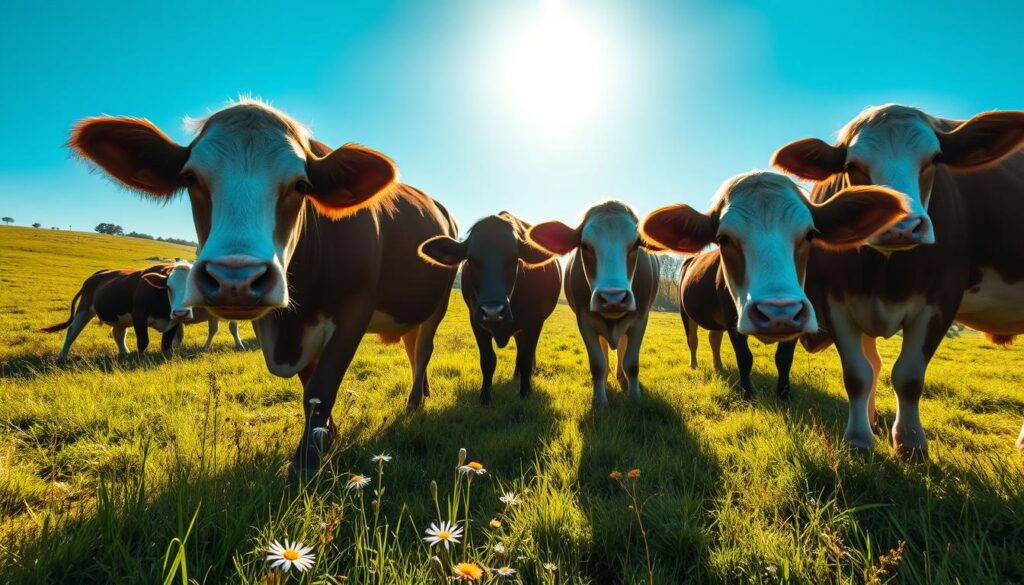
| Feeding System | Milk Color | Carotenoid Content |
|---|---|---|
| Grass-fed Cows | Pronounced yellow tint | Higher carotenoid levels |
| Grain-fed Cows | Paler, less vibrant yellow | Lower carotenoid levels |
The color and nutrients in milk depend on what cows eat. Cows eating green pastures full of carotenoids make milk that’s more yellow. On the other hand, cows eating grains or other foods make milk that’s paler.
Why Cow Milk is Yellow: The Key Reason
The yellow color of cow milk comes from beta-carotene. This pigment is found in carrots and pumpkins. It’s what makes them orange.
Beta-Carotene: The Pigment Behind the Color
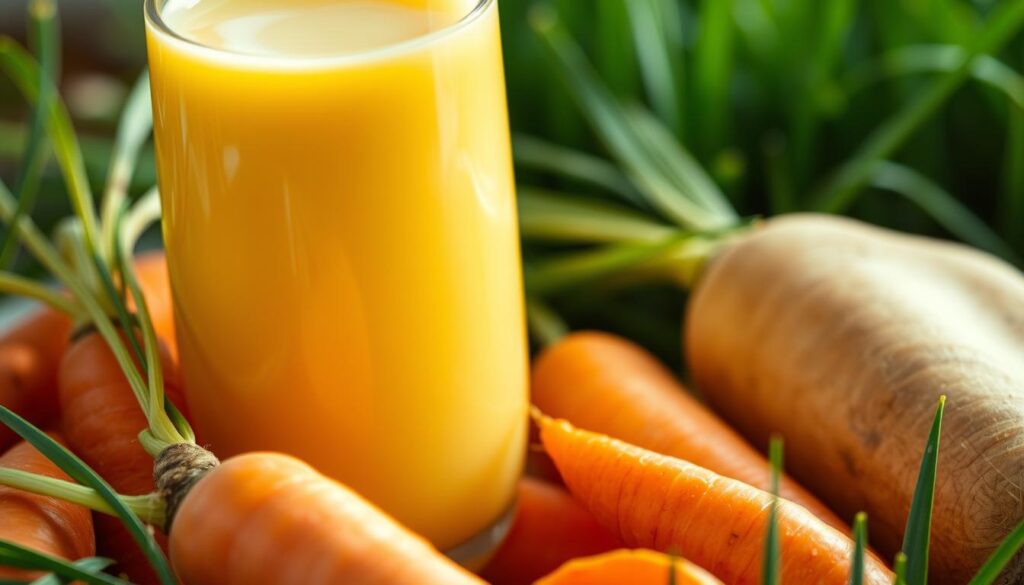
Cows eat foods rich in beta-carotene. This pigment goes into their milk, making it yellow. Beta-carotene is good for our eyes and immune system.
The yellow in milk can change based on the cow and the milk’s fat content. Cows eating grass and flowers with lots of beta-carotene make milk that’s more yellow.
Beta-carotene in milk is not just for looks. It’s also good for us. It protects our cells and keeps us healthy.
Milk Color Variations: Breed and Feed
The color of cow milk can change due to diet and breed. Some breeds, like Guernsey and Jersey cows, have milk that’s more yellow than others. This is because their milk has more fat, which helps keep carotenoids better.
Breed Differences in Milk Color
A study by Solah et al. (2007) looked at Western Australian Holstein-Friesian cows. They found that diet greatly affects milk color and content. Berry et al. (2009) also found a gene mutation that changes milk color.
Breed-specific traits also affect milk color. For example, Guernsey and Jersey cows have milk that’s deeper yellow. This is because they can better absorb and keep carotenoids than other breeds.
| Breed | Milk Fat Content | Milk Color |
|---|---|---|
| Guernsey | 4.9% | Deep yellow |
| Jersey | 4.8% | Pale yellow |
| Holstein-Friesian | 3.6% | Pale white |
The unique traits of each breed affect milk color. Their genetics and physiology influence how carotenoids are absorbed and stored in milk.
The Pasteurization Process and Milk Color
The pasteurization process is key to making milk safe and lasting longer. It can slightly change the milk’s color. The yellow in milk comes from carotenoids. Heat from pasteurization breaks down some of these pigments, making the milk look a bit paler than raw milk.
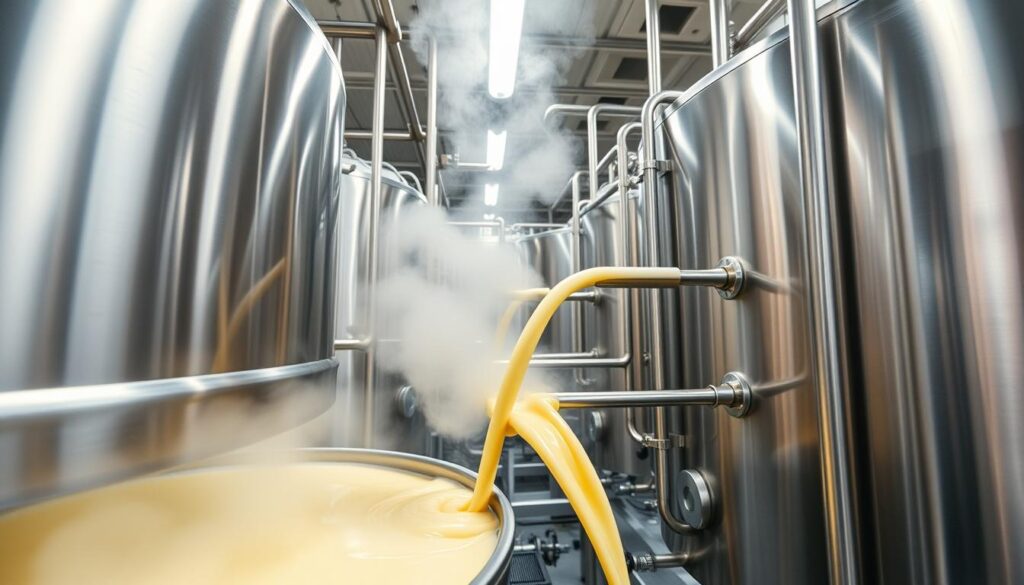
The pasteurization process heats milk to kill off bad bacteria. This includes Salmonella and E. coli, which can make people sick. The heat can also change the milk’s color in a few ways:
- Heat can break down carotenoids, like beta-carotene, making the milk look lighter or even white.
- The Alkaline Phosphatase test checks if milk is pasteurized right. It looks at the yellow color, which shows how active the enzyme is.
- The test uses sodium carbonate-bicarbonate buffer, which can also change the milk’s color.
Even though pasteurization changes the milk’s color a bit, it’s a vital step. It keeps milk safe, nutritious, and appealing to consumers.
| Milk Production Statistics | Value |
|---|---|
| Global Milk Production (2011) | 730 million tonnes |
| Number of Dairy Cows (2011) | 260 million |
| Top Milk Exporting Countries | India, New Zealand, Germany, Netherlands |
| People Living in Dairy-Farming Households | 750 – 900 million |
Seasonal Variations in Milk’s Yellow Tint
Cow milk’s yellow color changes with the seasons. In summer, when cows eat green pastures, their milk is more yellow. This is because their diet has more carotenoids, which change the milk’s color.
Summer vs. Winter Milk Colors
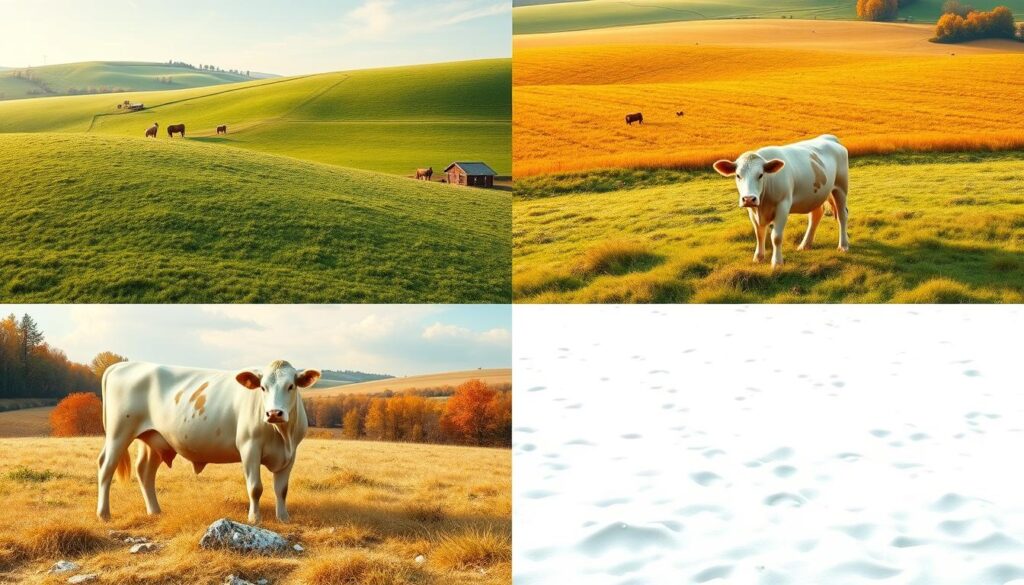
In winter, cows eat stored feed, and their milk is less yellow. Studies show that temperature and diet affect milk’s butterfat and nutrients, causing these color changes.
For example, spring milk from grass-fed cows has over 5% butterfat. This is more than the 3.5% standard for whole milk. It also has more beta-carotene, making it very yellow. Winter milk, on the other hand, is less yellow.
But the color change isn’t just about yellow. Researchers found that lightness index of cow and buffalo ghee changes too. Winter months have the highest lightness, while fall has the lowest.
These changes show how milk’s color can vary. It’s influenced by what cows eat, their environment, and how they’re farmed. Knowing this can help us appreciate the different qualities of milk and its products.
Milk Fat Content and Color Intensity
The fat in milk affects its yellow color. Whole milk or cream looks more yellow than skim milk. This is because the yellow pigments, called carotenoids, are fat-soluble. They stick better to the fatty parts of the milk.
Cow milk is mostly water, with 13% solids. The fat content is key to its color. Beta carotene, a pigment in milk fat, turns into vitamin A. It makes the milk yellow.
| Milk Fat Content | Color Intensity |
|---|---|
| Whole Milk | Vibrant Yellow |
| Reduced-Fat Milk | Lighter Yellow |
| Skim Milk | Pale Yellow |
Things like the cow’s breed and diet affect the milk’s color. Carotenoids and xanthophylls make the milk yellow. These come from the grass and flowers cows eat.
Knowing how fat content and color intensity relate is important. It helps in choosing the right milk for cooking. It also ensures dairy products look and taste the same every time.
Dairy Farming Practices: Impact on Milk’s Hue
The way cows are raised can change the color of their milk. Organic farms use no pesticides and feed cows green plants. This makes the milk more yellow than milk from cows on conventional farms.
Organic cows eat more carotenoids, which are pigments that make the milk yellow. This is different from conventional farms, where cows might not get as many of these nutrients.
Organic vs. Conventional Farming Methods
Organic farming uses natural methods and avoids harmful chemicals. Cows on organic farms eat better, which makes their milk more nutritious. This milk is full of carotenoids and vitamins.
Conventional farming is more industrial and might not keep the milk as healthy. This can make the milk less yellow.
The way cows are raised affects the milk’s color and health. More people want organic milk, which is good for farmers who want to meet this demand.
| Organic Dairy Farming | Conventional Dairy Farming |
|---|---|
| Cows fed on organic, carotenoid-rich grasses and forage | Cows fed on a diet of grains, silage, and limited grazing |
| No synthetic fertilizers or pesticides used | Synthetic fertilizers and pesticides commonly used |
| Milk typically has a deeper yellow color | Milk typically has a lighter, less vibrant color |
| Higher in carotenoids and fat-soluble vitamins | Lower in carotenoids and fat-soluble vitamins |
Knowing how farming affects milk color helps consumers make better choices. They can choose milk that fits their taste, nutrition, and values.
Cow Milk vs. Buffalo Milk: A Color Comparison
Cow milk is known for its yellow color. Buffalo milk, on the other hand, looks whiter or less vibrant. This color difference mainly comes from how buffalo and cows process carotenoids.
Buffalo milk has less carotenoids than cow milk. This is why buffalo milk doesn’t have the same yellow color. Cow milk gets its golden color from the cow’s ability to turn carotenoids into vitamin A.
| Characteristic | Cow Milk | Buffalo Milk |
|---|---|---|
| Color | Yellowish-white | Creamy white |
| Fat Content | 3-4% | 7-8% |
| Protein Content | 3.2-3.3% | 3.8-4% |
| Calories (per cup) | 148 | 237 |
| Water Content | 90% | 83% |
| Vitamin A Content | 2.1/100ml | 5.5/100ml |
The color difference between cow milk vs. buffalo milk mainly comes from carotenoids and vitamin A conversion. This natural variation makes these two milks unique.
Conclusion
The bright yellow color of cow milk comes from carotenoids, like beta-carotene. This is from the cows eating green, leafy plants. The milk gets its golden color from these natural pigments.
Things like the cow’s breed, how it’s farmed, the season, and the milk’s fat content can change the yellow color. This shows how different factors can affect the milk’s look.
Learning about milk’s color can make us appreciate its natural beauty more. We see that the yellow color comes from the cows’ diet. Different environments and farming methods can also change the color.
This knowledge helps us understand the beauty of milk. It’s not just a drink; it’s a reflection of nature’s complexity. Cow milk is loved for its taste, texture, and color.

